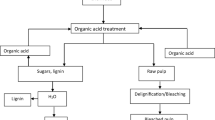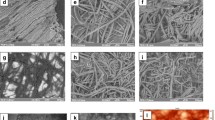Abstract
In this paper, four crops residues such as eggplant, cassava, okra and mulberry plants were assessed as papermaking raw materials. These crops residues had lower α-cellulose and holocellulose and moderate lignin content with syringyl:guaiacyl range of 1.05–1.63. The fiber length of eggplant, cassava, and mulberry plants were shorter (0.58–0.65 mm), while the same for okra plant was medium (1.14 mm). The Runkle ratios of these plant fibers were low (0.208–0.678), and flexibility coefficient was low to medium (55–79). All these non-wood plants were difficult to cook except eggplant plant. Eggplant plant produced screened pulp yield of 33.21 with kappa number of 22.9 at the conditions 3 h cooking at 170 °C with 20 alkali charge. Cassava plant showed the lowest screened pulp yield of 17.7% with kappa number 30.3 at the conditions 2 h cooking at 170 °C with 20 alkali charge. The okra plant pulp showed the best papermaking properties among these crops residues. Eggplant and okra plants can be used for brown packaging grade pulp.
Graphic Abstract






Similar content being viewed by others
References
Hanafi, E.M., El Khadrawy, H.H., Ahmed, W.M., et al.: Some observations on rice straw with emphasis on updates of its management. World Applied Sciences Journal 16, 354–361 (2012)
Kadam, L.K., Forrest, L.H., Jacobson, W.A.: Rice straw as a lignocellulosic resource: collection, processing, transportation and environmental aspects. Biomass Bioenerg. 18, 369–389 (2005)
Arai, H., Hosen, Y., Pham Hong, V.N., Thi, N.T., Huu, C.N., Inubushi, K.: Greenhouse gas emissions from rice straw burning and straw mushroom cultivation in a triple rice cropping system in the Mekong Delta. Soil Science and Plant Nutrition 61, 719–735 (2015)
Jahan, M.S., Rahman, M.M.: Characterization and evaluation of okra fibre (abelmoschus esculentus) as a pulping raw material. J-For, J Sci Technol Forest Prod Process 2(5), 1–17 (2012)
Omer, S.H., Khider, T.O., Elzaki, O.T., Mohieldin, S.D., Shomeina, S.K.: Application of soda-AQ pulping to agricultural waste (Okra Stalks) from Sudan. BMC Chemical Engineering 1(1), 6 (2019). https://doi.org/10.1186/s42480-019-0005-9
Rahman, M.M., Jahan, M.S.: Evaluation of mulberry plant as a pulping raw material. Biomass Conversion and Biorefinery 4(1), 53–58 (2014)
Chen, C. L.; Nitrobenzene and cupric oxide oxidations. In: Methods in lignin chemistry. Springer, Berlin, Heidelberg (1992). 301–321
Ferdous, T., Quaiyyum, M.A., Bashar, S., Jahan, M.S.: Anatomical, morphological and chemical characteristics of kaun straw (Seetaria-ltalika). Nord. Pulp Pap. Res. J. (2020). https://doi.org/10.1515/npprj-2019-0057
Sitch, D.A., Marshall, H.B.: The effect of hemicelluloses on the papermaking properties of white birch. Canadian Journal of Research 28(10), 376–389 (1950)
Haque, M.M., Aziz, M.I., Hossain, M.S., Quaiyyum, M.A., Alam, M.Z., Jahan, M.S.: Pulping of hybrid acacia planted in a social forestry program in Bangladesh. Cellul. Chem. Technol. 53(7–8), 739–745 (2019)
Sun, R., Mott, L., Bolton, J.: Isolation and fractional characterization of ball-milled and enzyme lignins from oil palm trunk. Journal of agricultural and food chemistry 46(2), 718–723 (1998)
Sun, R.C., Fang, J.M., Goodwin, A., Lawther, J.M., Bolton, A.J.: Physico-chemical and structural characterization of alkali lignins from abaca fibre. J. Wood Chem. Technol. 18(3), 313–331 (1998)
Creighton, R.H.J., Gibbs, R.B., Hibbert, H.: Studies on lignin and related compounds LXXV: Alkaline nitrobenzene oxidation of plant materials and application to Taxonomic Classification. J. Amer. Chem. Soc. 66, 32–37 (1944)
Sharma, A.K., Dutt, D., Upadhyaya, J.S., Roy, T.K.: Anatomical, morphological, and chemical characterization of Bambusa tulda, Dendrocalamus hamiltonii, Bambusa balcooa, Malocana baccifera. Bambusa arundinacea and Eucalyptus tereticornis. Bioresources 6(4), 5062–5073 (2011)
Kaur, H., Dutt, D.: Anatomical, morphological and chemical characterization of lignocellulosic by-products of lemon and sofia grasses obtained after recuperation of essential oils by steam distillation. Cellul. Chem. Technol. 47(1–2), 83–94 (2013)
Horn, R. A.;. Morphology of Pulp Fiber from Hardwoods and Influence on Paper Strength (No. FSRP-FPL-312). Forest Products Lab Madison Wis. (1978)
Dinwoodie, Jm: The relationship between fibre morphology and paper properties: a review of literature. Tappi J. 48, 440–447 (1965)
Ona, T., Sonoda, T., Ito, K., Shibata, M., Tama, Y., Kojim, Y., Ohshima, J., Yokota, S., Yoshizawa, N.: Investigation of relationship between cell and pulp properties in Eucalyptus by examination of within-tree property variations. Wood Sci. Technol. 35, 363–375 (2001)
Ververis, C., Georghiou, K., Christodoulakis, N., Santas, P., Santas, R.: Fiber dimensions, lignin and cellulose content of various plant materials and their suitability for paper production. Ind. Crops Prod. 19, 245–254 (2004)
Jahan, M.S., Haque, M.M., Quaiyyum, M.A., Nayeem, J., Bashar, M.S.: Radial variation of anatomical, morphological and chemical characteristics of Acacia auriculiformis in evaluating pulping raw material. Journal of the Indian Academy of Wood Science 16(2), 118–124 (2019)
Granholm, K., Harju, L., Ivaska, A.: Desorption of metal ions from kraft pulps, part 1, chelation of hard wood and softwood kraft pulp with EDTA. BioResources 5, 206–226 (2010)
Colodette, J.L.; Highlights of the 5th colloquium on eucalyptus pulp proceeding peers conference, Portland-OR,
Mabilanganm, L., Estudillo, C.: Philippines woods suitable for kraft pulping process. Trade Bulletin Series 5, 1–9 (1996)
Amidon, T.E., Te, A.: Effect of the wood properties of hardwoods on kraft paper properties. Tappi J. 64, 123–126 (1981)
Khiari, R., Mhenni, M.F., Belgacem, M.N., Mauret, E.: Chemical composition and pulping of date palm rachis and Posidonia oceanica–A comparison with other wood and non-wood fibre sources. Biores. Technol. 101(2), 775–780 (2010)
Jahan, M.S., Kanna, G.H., Mun, S.P., Chowdhury, D.N.: Variations in chemical characteristics and pulpability within jute plant (Chorcorus capsularis). Ind. Crops Prod. 28(2), 199–205 (2008)
Jahan, M.S., Chowdhury, D.N., Islam, M.K.: Pulping of dhaincha (Sesbania aculeata). Cellul. Chem. Technol. 41(7), 413 (2007)
Tsutsumi, Y., Kondo, R., Sakai, K., Imamura, H.: The difference of reactivity between syringyl lignin and guaiacyl lignin in alkaline systems. Holzforschung 49, 423–428 (1995)
Seth, R. S.; Fibre Quality Factors in Papermaking—I The Importance of Fibre Length and Strength. MRS Online Proceedings Library Archive, 197.) (1990).
Levlin, J.-E.; Söderhjelm L.; (Eds.), Pulp and Paper Testing, first edition, Helsinki, (1999).
Author information
Authors and Affiliations
Corresponding author
Additional information
Publisher's Note
Springer Nature remains neutral with regard to jurisdictional claims in published maps and institutional affiliations.
Rights and permissions
About this article
Cite this article
Ferdous, T., Quaiyyum, M.A. & Jahan, M.S. Characterization and Pulping of Crops Residue: Eggplant, Cassava, Okra and Mulberry Plants. Waste Biomass Valor 12, 3161–3168 (2021). https://doi.org/10.1007/s12649-020-01236-6
Received:
Accepted:
Published:
Issue Date:
DOI: https://doi.org/10.1007/s12649-020-01236-6




